22 Kitchen Tools Your Great-Grandparents Used Daily (And You’ve Never Heard Of)
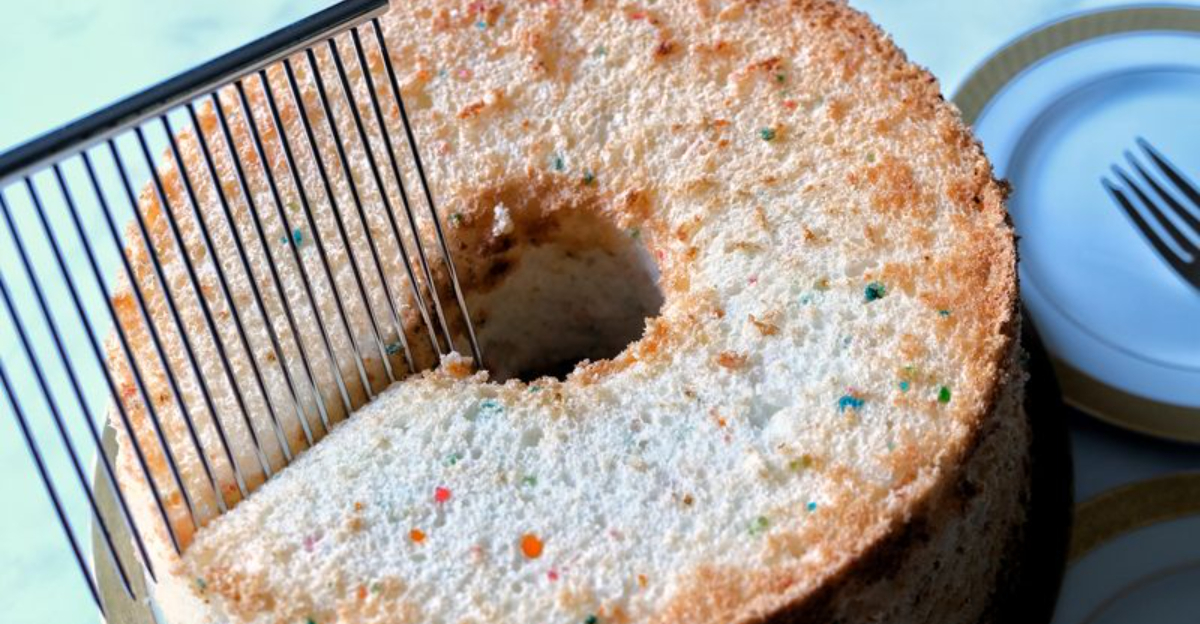
While rummaging through my grandmother’s attic last weekend, I uncovered a treasure trove that felt like stepping into a time machine—an old wooden crate brimming with the quirkiest kitchen contraptions you’ve ever seen.
At first glance, I half expected some of them to start whirring to life like steampunk robots. But no, these odd-looking gadgets weren’t props from a sci-fi film—they were the real-deal tools our ancestors used to whip up meals long before blenders and air fryers took over.
Imagine trying to grind coffee with a tiny hand-cranked mill or slice apples with a device that looks more like a medieval trap than a kitchen helper. Everything required muscle, patience, and a touch of wizardry.
From butter churns to egg beaters that looked like they belonged in a toolbox, these relics told stories of a time when cooking was an art powered by elbow grease and sheer determination. Let’s explore!
1. Butter Churn: From Cream to Spread in Minutes
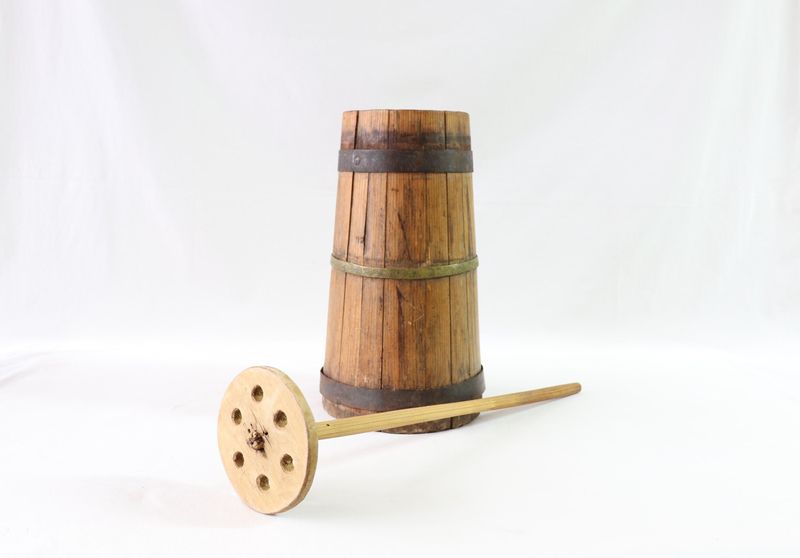
My great-aunt Mildred could churn butter faster than anyone in her county. The rhythmic thump-thump-thump of her wooden dash churn was practically the soundtrack of her farmhouse kitchen.
Butter churns transformed cream into butter through constant agitation. The most common types were the dash churn (a staff with a cross at the bottom pushed up and down in a barrel) and the crank churn (a paddle mechanism turned by hand inside a container). After sufficient churning—sometimes up to an hour—the cream would suddenly “break” and separate into butter and buttermilk.
Once the butter formed, it was rinsed with cold water, salted for preservation, and sometimes pressed into decorative molds. One gallon of cream typically yielded about two pounds of butter. Many farm families churned twice weekly, selling excess butter as valuable income.
2. Sad Iron: The Weighty Clothes Presser
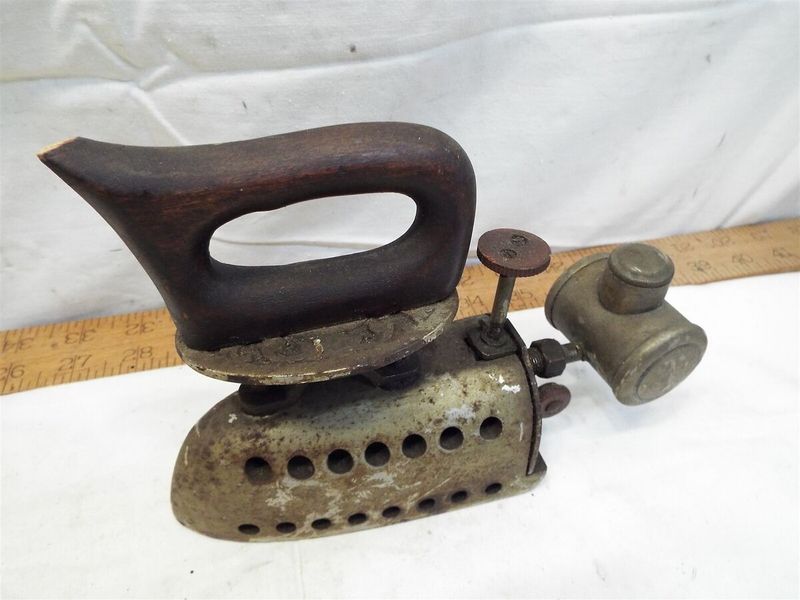
“Sad” didn’t refer to the iron’s emotional state but rather to its solid, heavy nature. I once tried lifting my grandmother’s collection—my arms nearly gave out!
These hefty cast-iron tools weighed between 5-15 pounds and required serious muscle to maneuver across clothing. Homemakers would heat several irons directly on wood stoves or over open fires, using one while others heated. A clever rotating handle allowed users to pick up the scorching-hot base without burning themselves. Many sad irons came with detachable wooden handles that stayed cool.
Interestingly, these versatile tools often doubled as impromptu cooking devices. Flipped upside down, they became emergency griddles for making flatbreads or pressing sandwiches when cooking space was limited. Some models even featured decorative bases with manufacturer logos or intricate patterns that transferred to fabrics.
3. Potato Ricer: The Original Mashed Potato Maker
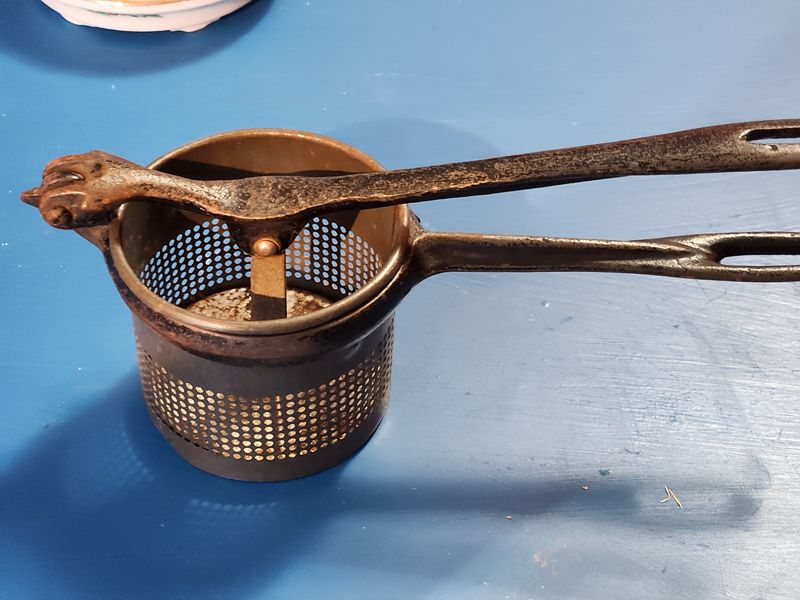
Thanksgiving at my great-grandmother’s house always featured the fluffiest mashed potatoes, courtesy of her treasured potato ricer. Unlike modern mashers that leave chunks, this ingenious tool created cloud-like perfection.
Resembling an oversized garlic press, the potato ricer forced cooked potatoes through small holes, creating fine, rice-like strands that formed the base for incredibly smooth mashed potatoes. Users would place boiled potatoes in the bowl-shaped chamber, then squeeze the handles together, pressing a plunger that extruded the potatoes through the perforated base.
Beyond potatoes, these versatile tools helped homemakers prepare baby food, fruit purees, and even homemade noodles. The ricer’s design eliminated lumps entirely—something no potato masher could achieve. Many families passed their cherished potato ricers down through generations, with some models made from wood, tinned steel, or cast aluminum.
4. Cherry Pitter: The Pie-Maker’s Best Friend
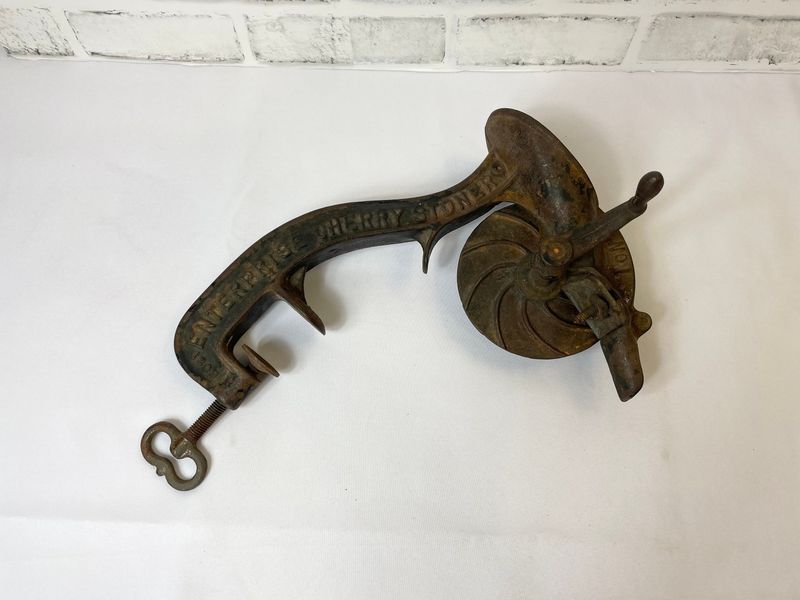
Cherry season meant pie-making marathons in my family’s rural kitchen, and this little gadget prevented hours of stained fingers and tedious work. Before modern conveniences, cherry pitting was a communal activity!
The hand-operated cherry pitter featured a small cup to hold each cherry and a spring-loaded plunger that pushed the pit through a hole in the bottom. Early models were often crafted from cast iron or tin with wooden handles, requiring users to process each cherry individually. More advanced designs could pit multiple cherries simultaneously, significantly speeding up the process.
Families would gather around kitchen tables during summer harvests, pitting pounds of cherries for pies, preserves, and drying. Children often participated in this sticky but enjoyable task. The distinctive clicking sound of the pitter became associated with upcoming cherry treats and the promise of delicious desserts preserved for the winter months ahead.
5. Toasting Fork: The Original Bread Toaster
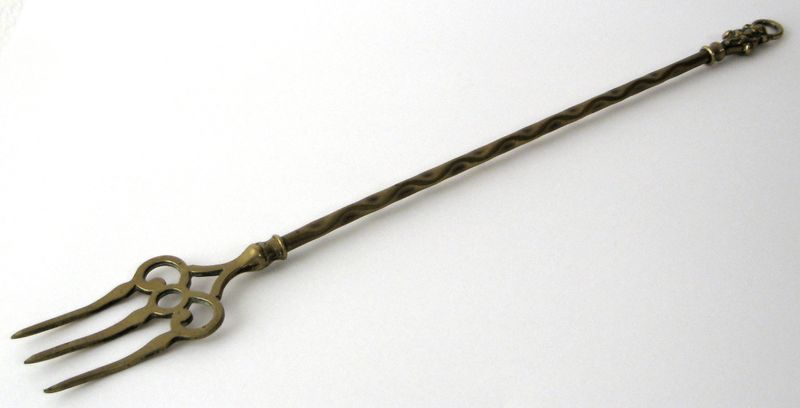
Breakfast toast wasn’t always as simple as pushing down a lever. My grandfather told stories of fighting with his siblings over who got to use the toasting fork each morning—apparently, it was considered the fun job in their household!
Long before electric toasters, these extended forks with multiple tines held bread slices near open flames. Crafted with wooden handles to prevent heat transfer, toasting forks often stretched 24-36 inches long, keeping users safely away from the fire. The tines typically featured decorative patterns and occasionally included a sliding shield to protect hands from heat.
Using a toasting fork required skill and patience. Too close to flames meant burnt toast; too far meant underdone bread. Users needed to constantly rotate the bread for even browning. Many toasting forks included decorative elements like carved handles or ornate metalwork, making them both functional tools and kitchen decor when hung by the fireplace or stove.
6. Sausage Stuffer: The Homemade Meat Processor
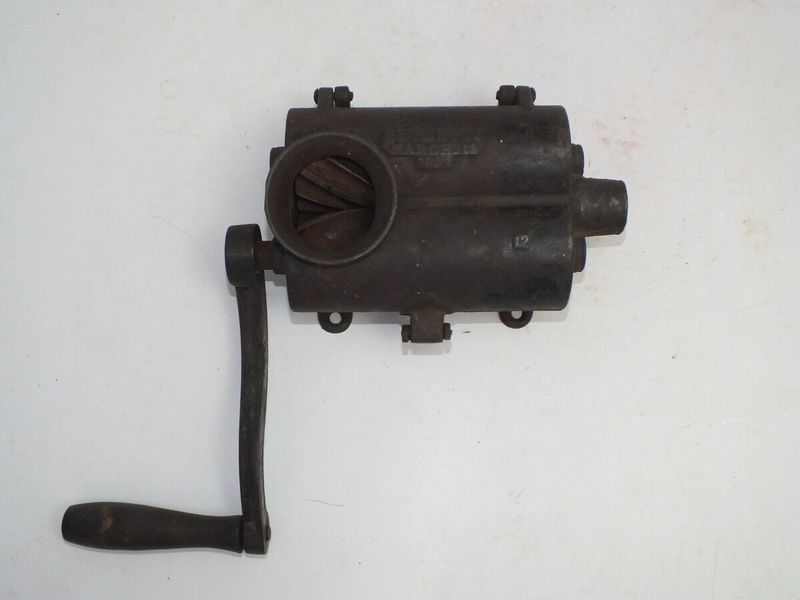
Fall butchering days on my great-grandfather’s farm always culminated with the appearance of the cast iron sausage stuffer. The mysterious contraption transformed scraps into winter’s most cherished protein source.
This hand-cranked device consisted of a cylinder for holding ground meat mixture, a plunger operated by a gear mechanism, and various sized funnels called horns. Families would first clean animal intestines for casings, then mix meat with salt, herbs, and spices. The mixture was packed into the cylinder, and turning the crank forced meat through the horn and into the casing.
Sausage-making was typically a whole-family affair, with children helping to turn the crank while adults guided the filling casings. Different horn sizes created everything from breakfast links to large bologna-style sausages. The process preserved valuable meat through winter months when fresh meat was scarce, and family sausage recipes became treasured heirlooms passed through generations.
7. Food Mill: The Manual Food Processor
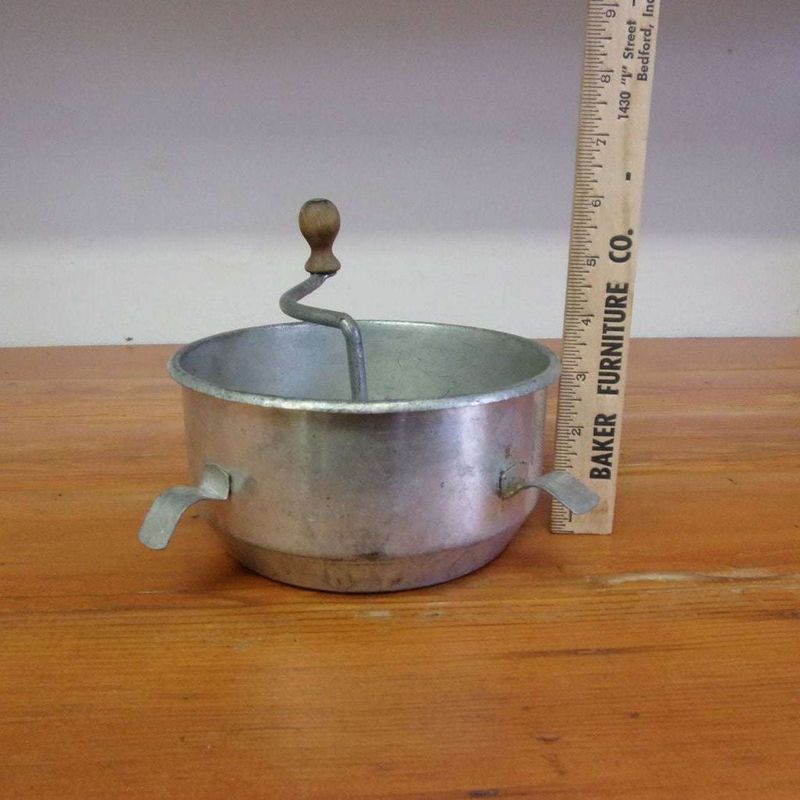
Grandma’s applesauce had a perfectly smooth consistency that I’ve never been able to replicate with modern appliances. Her secret weapon? A sturdy food mill that separated seeds and skins while creating velvety purees.
The hand-operated food mill consisted of a bowl with a perforated bottom, a curved blade that pressed against it, and a crank handle. As users turned the handle, the blade forced soft foods through the perforations while leaving seeds, skins, and tough fibers behind. Different discs with various-sized holes could be swapped out depending on the desired texture.
Before electric food processors, this versatile tool was essential for making baby food, tomato sauce, fruit purees, and smooth mashed vegetables. Many mothers credited food mills with helping them introduce solid foods to infants. Made from tinned steel, aluminum, or stainless steel, a quality food mill lasted generations and often became a cherished family heirloom passed down through kitchens.
8. Flour Sifter with Crank: The Baking Essential
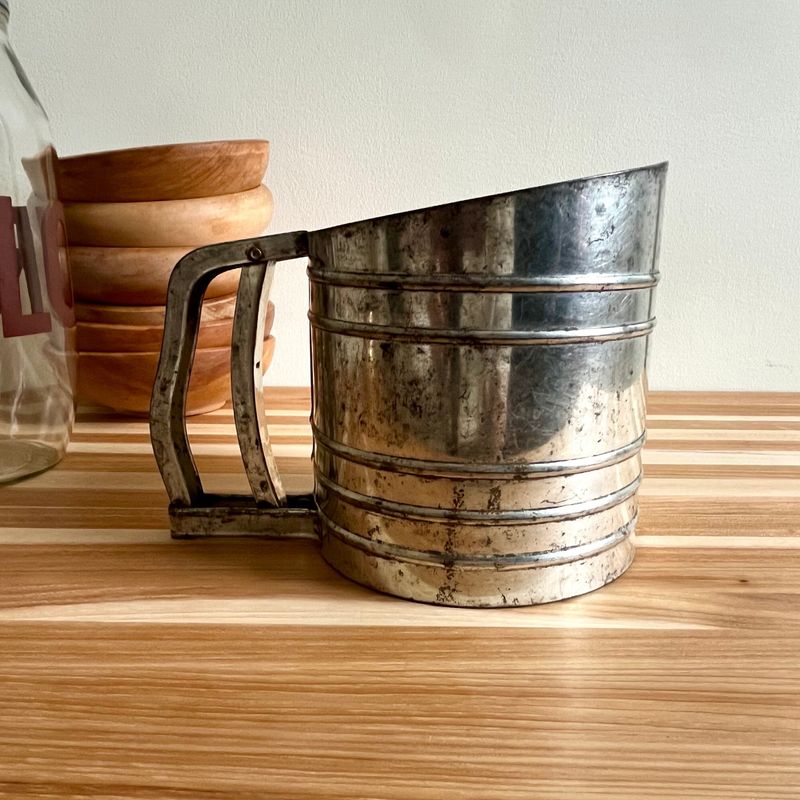
The distinctive whir-whir-whir of my grandmother’s flour sifter announced that something delicious was about to happen in the kitchen. No proper cake or bread began without this crucial step!
Unlike today’s pre-sifted flour, historical flour often contained impurities, lumps, and even the occasional insect that needed removal. The crank sifter featured a cylindrical container with a fine mesh screen at the bottom and internal paddles operated by a side crank. As the user turned the handle, the paddles pushed flour through the mesh, aerating it while removing unwanted elements.
Proper sifting incorporated air into flour, resulting in lighter baked goods with better texture. Many recipes called for sifting multiple times for especially delicate cakes. Vintage sifters typically held 3-5 cups of flour and were made from tin or aluminum with measurements marked on the side. Some featured charming decorative patterns that brightened up kitchens and made them display-worthy tools.
9. Butter Mold: The Dairy Decorator
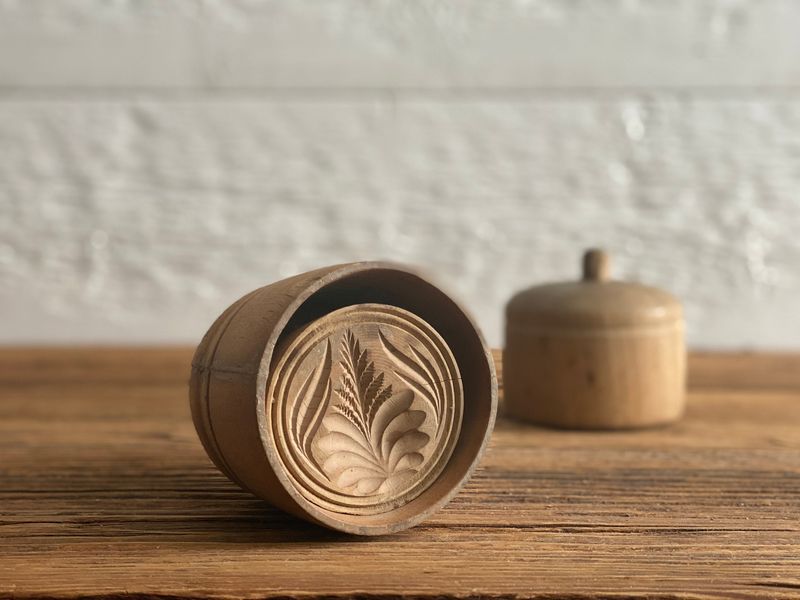
Finding my great-grandmother’s wooden butter mold at an estate sale brought tears to my eyes—I remembered the beautiful butter shapes that graced our holiday tables, each imprinted with an intricate wheat pattern.
After churning butter, homemakers pressed it into these decorative wooden molds to create uniform shapes adorned with detailed designs. Carved from a single piece of hardwood (typically maple or fruitwood), these molds featured motifs like flowers, animals, wheat sheaves, or patriotic symbols pressed into the bottom. Some were simple round or rectangular blocks, while others used a plunger mechanism to release the molded butter.
Beyond aesthetics, butter molds served practical purposes, creating uniform portions for selling or serving. Farmers often used distinctive designs as branding for their dairy products at market. Before use, molds were soaked in cold water to prevent sticking, and after pressing, the decorated butter was often chilled to maintain its intricate design before presenting it at the table.
10. Egg Coddler: The Gentle Egg Cooker
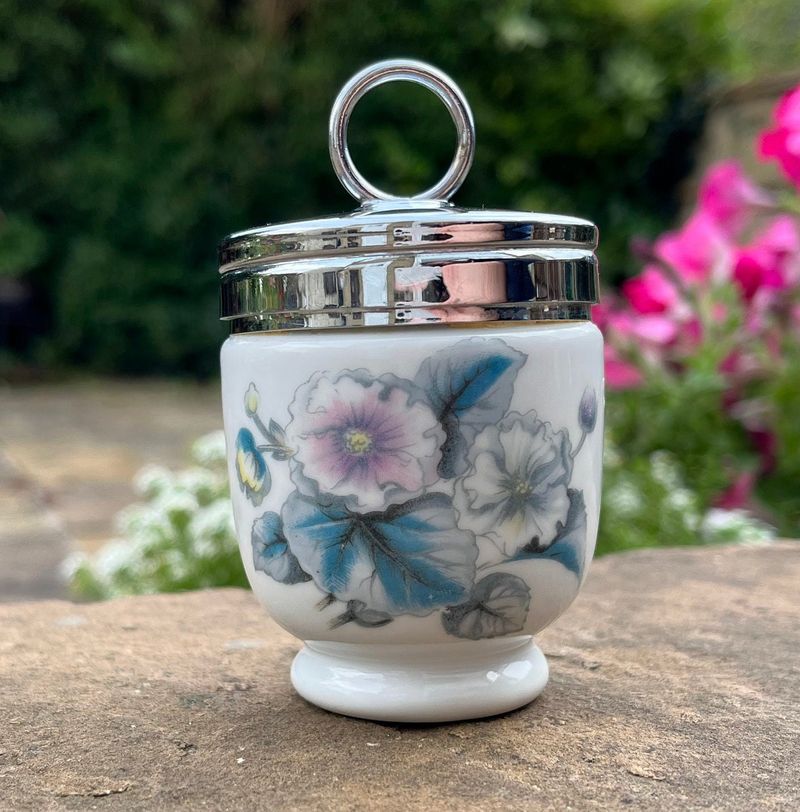
My mother still uses her grandmother’s porcelain egg coddlers for special Sunday breakfasts. The delicate cups with their screw-on lids create the silkiest, most luxurious eggs I’ve ever tasted.
These specialized porcelain cups gently cooked eggs to a consistency between poached and soft-boiled. Users would butter the inside of the coddler, crack in an egg (sometimes with cream, herbs, or cheese), secure the lid, and lower it into simmering water. The result was a tender egg with a barely-set white and warm, runny yolk—perfect atop toast or vegetables.
Popular in British households since Victorian times, egg coddlers often featured delicate hand-painted designs or transferware patterns. The porcelain construction provided gentle, even heat distribution that prevented the rubbery texture common with other cooking methods. Many families collected different patterns and sizes, from single-egg coddlers to double models that prepared two eggs simultaneously. The ritual of coddling eggs became associated with leisurely weekend breakfasts and special occasions.
11. Ice Pick: The Refrigeration Assistant
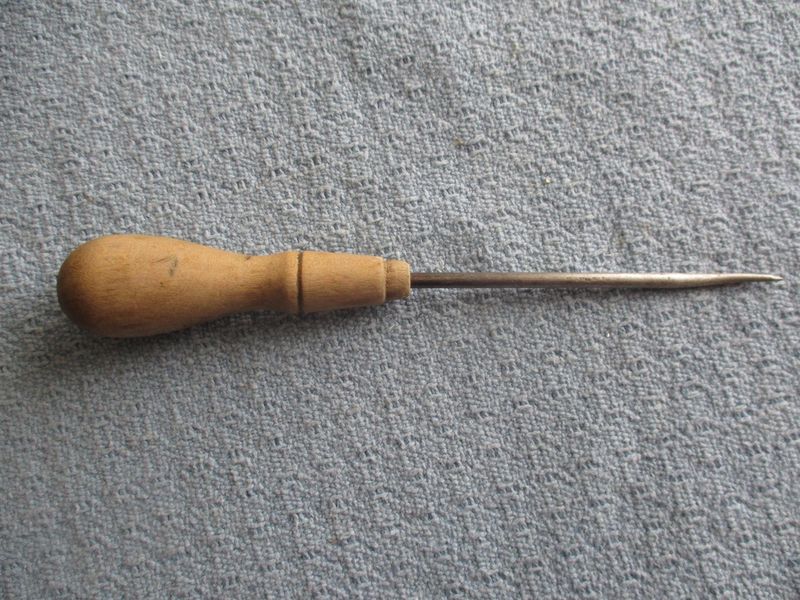
“Watch your fingers!” My grandfather’s warning still echoes in my memory whenever I picture his menacing-looking ice pick—a tool that was once as essential as a modern refrigerator’s power cord.
Before electric refrigeration, families purchased large blocks of ice from delivery services to keep their iceboxes cold. The ice pick, featuring a wooden handle and sharp metal spike, was used to chip manageable pieces from these unwieldy blocks. Skilled users could quickly create ice chunks of various sizes for different cooling needs or for making summer treats.
Beyond its primary purpose, the ice pick served as an impromptu hole punch, leather awl, and even a food pick for selecting pickles from barrels. Most households kept their ice pick hanging near the icebox for daily use. The tool’s design remained largely unchanged for decades—a testament to its simple effectiveness. When electric refrigerators finally made ice delivery obsolete, many ice picks were repurposed as garden tools or workshop implements.
12. Nutmeg Grater: The Spice Specialist
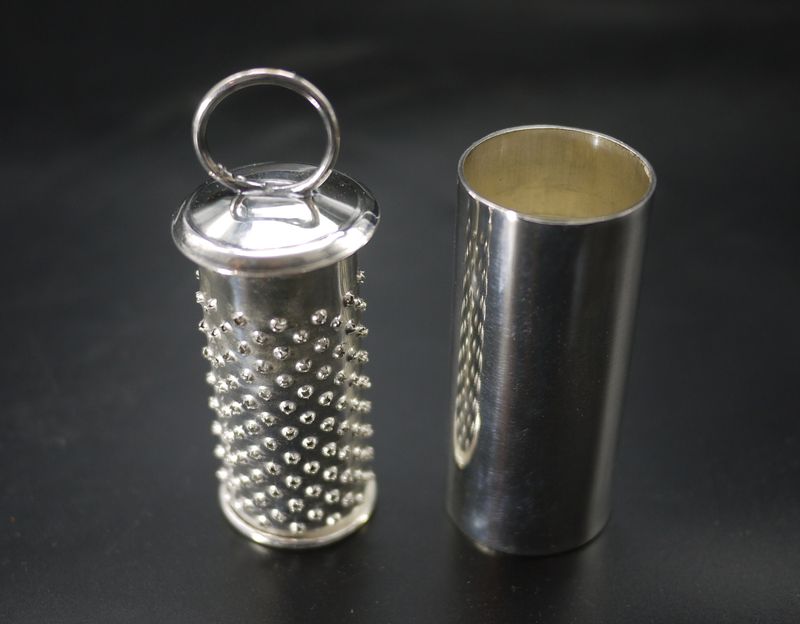
The pocket-sized silver nutmeg grater I inherited from my grandmother still carries the faint aroma of countless holiday eggnogs and spiced custards. This tiny tool made a world of difference in the flavor of historical recipes.
Before pre-ground spices, cooks kept whole nutmegs and grated them fresh for each use, preserving their potent essential oils. These specialized graters featured extremely fine teeth that shaved the hard nutmeg seed into a fine powder. Many designs included a small compartment for storing unused nutmegs, making them portable for the spice-loving cook.
Nutmeg graters often reflected their owners’ social status. Working-class kitchens used simple tin models, while wealthy households might display silver or ivory graters with intricate engravings. The nutmeg itself was once so valuable that carrying your personal grater signaled prosperity. Freshly grated nutmeg appeared in everything from savory meat dishes to medicinal tonics, where its aromatic compounds were believed to aid digestion and prevent illness.
13. Lard Cutter: The Pastry Chef’s Secret
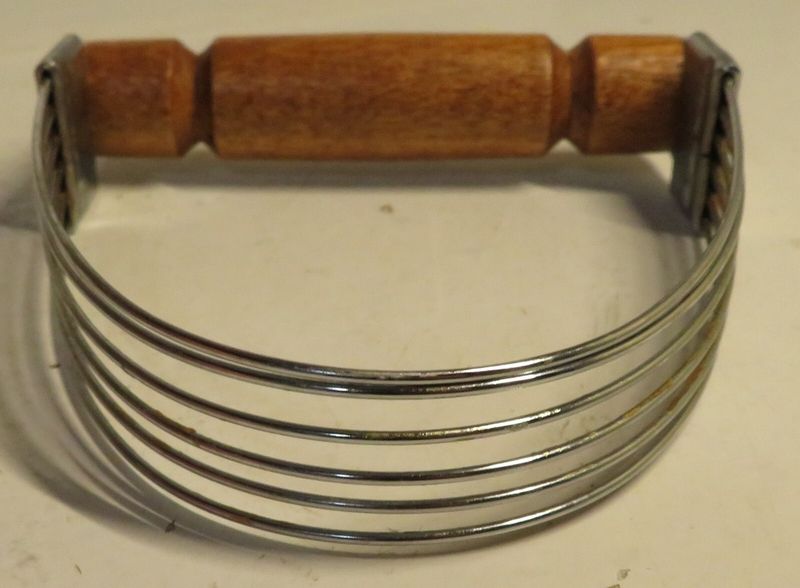
Grandma’s pie crust had a flakiness that defied modern recipes, and her lard cutter (now called a pastry blender) was her most guarded baking tool. She’d shoo us kids away when using it—claiming it required a special touch only experienced bakers possessed.
This hand-held tool featured multiple parallel blades or wires attached to a handle, designed to cut solid fat into flour without warming or overworking the mixture. The result was the perfectly distributed fat pockets that created flaky layers in pastry. Early versions were crafted from wood and metal, with blades arranged in a curved pattern that matched the contour of mixing bowls.
Before food processors, this simple tool was essential for proper pastry technique. Experienced bakers could judge perfect dough consistency by the feel of the lard cutter moving through the flour mixture. Many home cooks developed a deep attachment to their particular lard cutter, claiming new ones never worked quite as well as their broken-in favorite that had made hundreds of pies.
14. Cake Breaker: The Delicate Dessert Tool
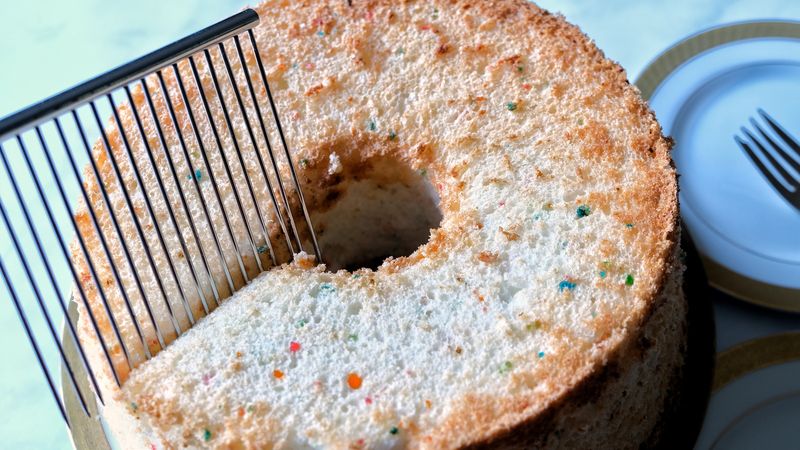
The first time I saw my aunt’s cake breaker, I mistook it for an unusual comb. “That’s how we cut angel food cake without crushing it,” she explained, demonstrating how the thin metal tines sliced through the delicate confection without compression.
Unlike conventional knives that compress soft cakes while cutting, this specialized tool featured rows of thin, parallel tines that separated cake layers with minimal pressure. The result was picture-perfect slices of angel food, chiffon, and sponge cakes that maintained their airy texture. Most cake breakers had a comfortable handle connected to a semicircular row of metal tines.
This tool became particularly popular during the 1920s-1950s when light, airy cakes were fashionable desserts for ladies’ luncheons and afternoon teas. Cake breakers were often given as wedding gifts, with some featuring silver-plated handles and decorative elements. Though primarily designed for cakes, clever cooks also used them for serving delicate casseroles, terrines, and other soft dishes that would be damaged by conventional serving utensils.
15. Spatterware Coffee Pot: The Campfire Brewer
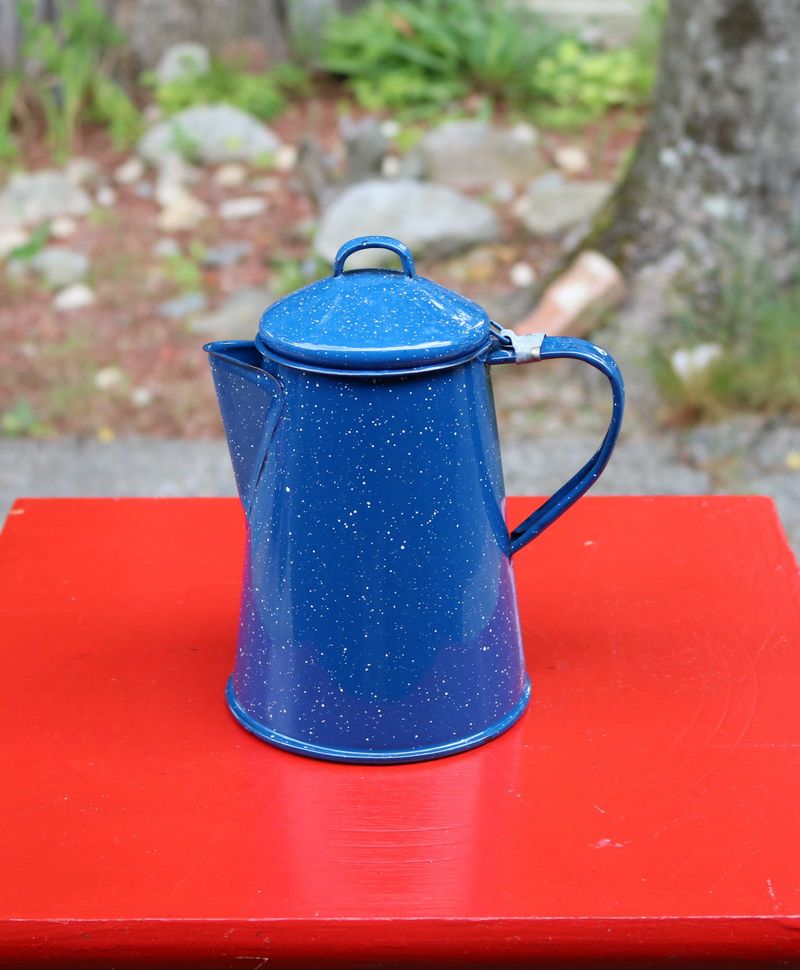
During power outages, my father would dig out his grandmother’s speckled blue enamel coffee pot, claiming “real coffee” could only be made in this ancient vessel. The distinctive spattered pattern brings back memories of stormy nights lit by kerosene lamps.
Spatterware coffee pots were distinctive enamelware vessels with a speckled or splattered decoration created by flicking contrasting enamel onto a base color before firing. These durable pots could withstand direct flame contact, making them ideal for wood stoves or campfires. Their wide bottoms and narrow tops created the perfect conditions for brewing coffee using the boiling method popular before percolators.
Beyond their practical use, these colorful pots often served as kitchen decoration when not in use. The most common colors were blue and white, though red, green, and multicolored spatterware existed. The unique speckled finish helped disguise the inevitable stains and wear that came with daily use over open flames, making them both practical and attractive for hardworking kitchens.
16. Rolling Herb Cutter: The Garnish Gadget
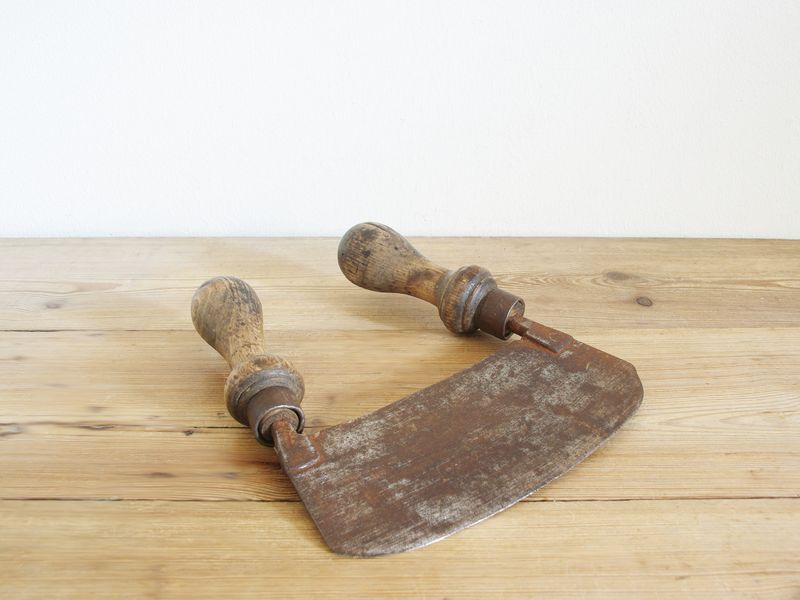
My Italian great-grandmother’s mezzaluna (half-moon herb cutter) still hangs in my kitchen—a testament to centuries of cooking wisdom. She could chop parsley faster with this curved blade than any modern food processor.
This specialized cutting tool featured one or more curved blades attached to handles, resembling a half-moon shape (hence the Italian name “mezzaluna”). Users would rock the blade back and forth over herbs placed on a cutting board, producing finely minced greens without bruising them as modern blades often do. Multi-bladed versions could process larger quantities even faster.
Before electric food processors, this efficient tool saved considerable time when preparing herb-heavy dishes. The rocking motion was gentle on the wrists compared to standard knife chopping, allowing cooks to process large quantities of herbs without fatigue. Many European and Mediterranean kitchens considered the herb cutter essential for daily cooking, with designs varying by region. Some featured single handles, while others had handles at both ends of the curved blade.
17. Bean Stringer and Slicer: The Vegetable Prepper
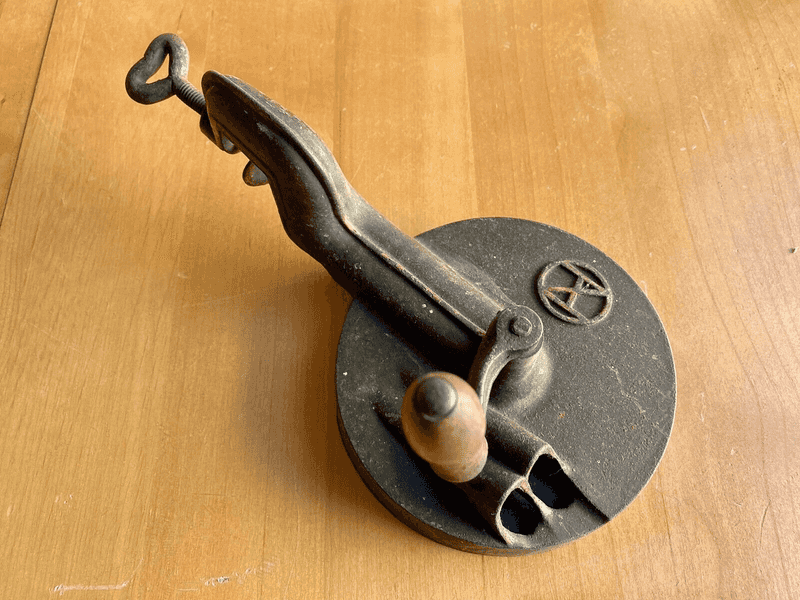
Summer garden harvests at my grandparents’ farm meant hours of bean preparation—until Grandpa pulled out his ingenious bean stringer. “This little gadget saved your grandmother’s fingers during canning season,” he’d proudly explain while demonstrating its clever mechanism.
This specialized tool combined multiple bean-preparation steps into one efficient motion. Featuring a small blade to remove strings and a slicing mechanism to cut beans into uniform pieces, it significantly reduced preparation time for large harvests. Users would pull fresh green beans through the tool, which simultaneously removed the tough string running along the bean’s seam and sliced it into pieces ready for cooking or canning.
During summer harvests, when bushels of beans required processing before spoiling, this tool was invaluable. Many designs clamped to table edges for stability during use. The uniform cutting ensured even cooking, while the complete string removal prevented the unpleasant fibrous texture that ruined many bean dishes. For farm families who preserved dozens of quarts of green beans annually, this specialized tool was worth its weight in gold.
18. Wire Egg Separator: The Baking Helper
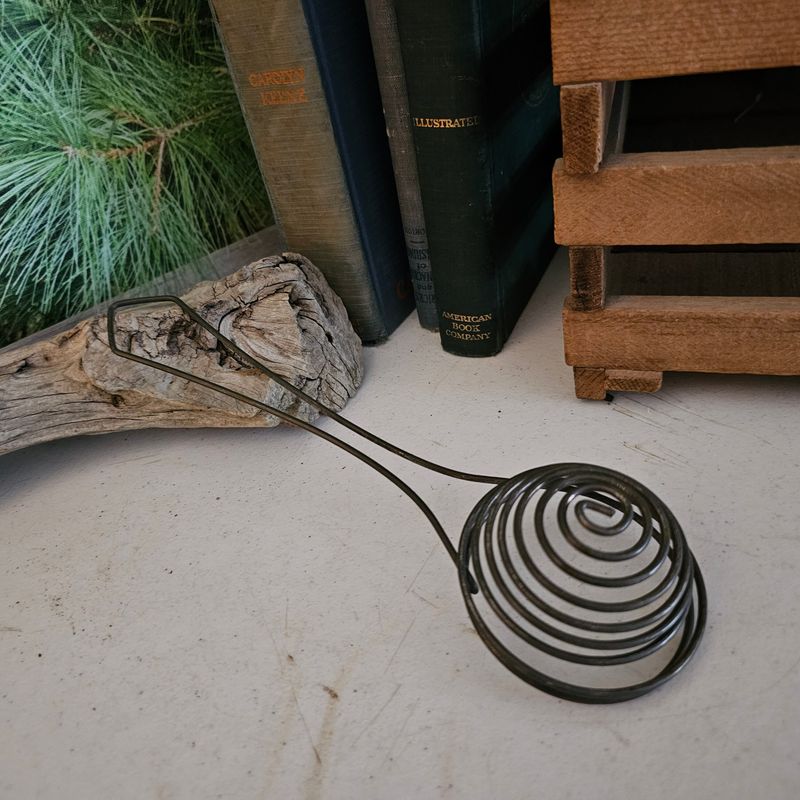
The simple wire contraption hanging in my grandmother’s kitchen puzzled me as a child until she demonstrated its egg-separating magic. “Before you could crack eggs on the side of a bowl, this little wire wonder did all the work,” she explained.
This ingenious device consisted of a wire cradle designed to catch egg yolks while allowing whites to slip through. Users would crack an egg into the separator, which was positioned over a bowl. The yolk remained in the wire cradle while the white dripped through the spaces between the wires into the bowl below.
For recipes requiring separated eggs—like angel food cakes, meringues, or custards—this tool eliminated the risk of broken yolks contaminating whites. Early models were handcrafted from bent wire, while later commercial versions added handles and decorative elements. The simple design remained largely unchanged for generations, proving that sometimes the simplest tools are the most effective. Many bakers insisted that wire separators worked better than the shell-to-shell method or modern plastic separators.
19. Cream Separator: The Dairy Station
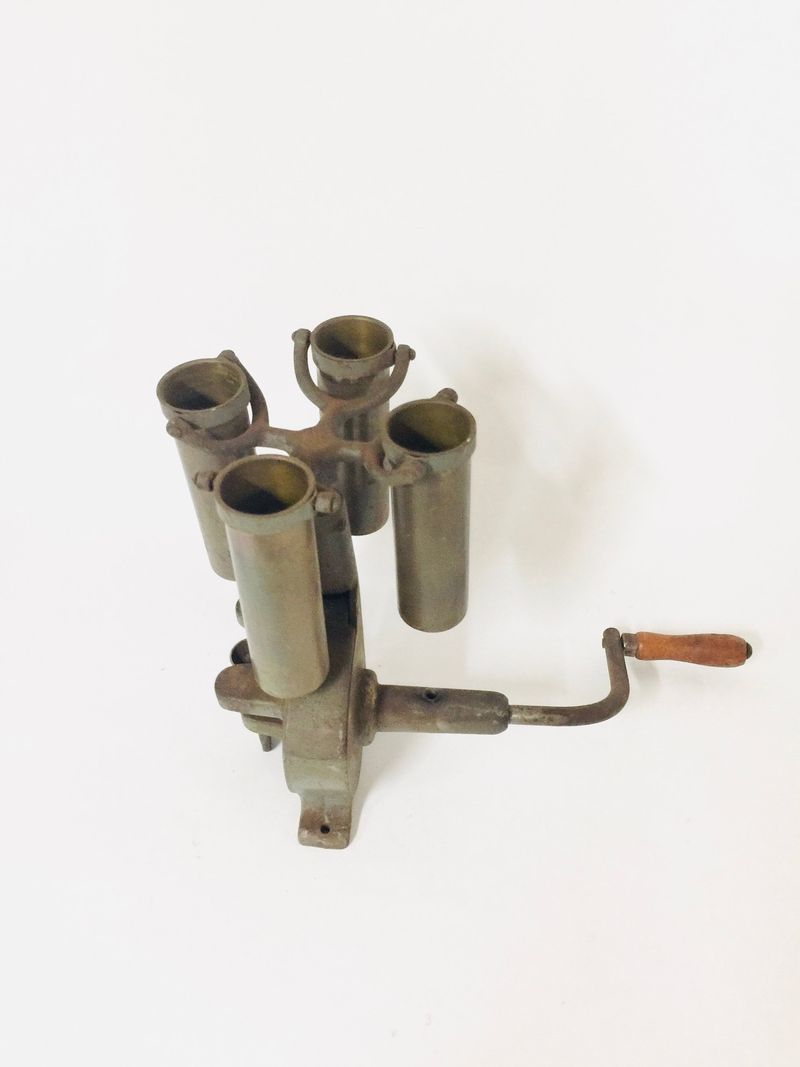
The massive cream separator dominating my great-uncle’s farm kitchen looked like something from a steampunk novel. “This mechanical marvel paid for our first automobile,” he once told me, patting its intricate gears with obvious pride.
This substantial machine used centrifugal force to separate cream from milk—a process that otherwise required hours of letting milk sit until cream naturally rose to the top. Featuring a hand crank that spun a series of internal discs at high speed, the separator forced heavier milk solids outward while lighter cream moved toward the center, with each flowing through separate spouts.
For dairy farmers, this invention revolutionized production, allowing them to process milk quickly after milking rather than waiting 24 hours for natural separation. The valuable cream could be sold or made into butter, while skim milk was used for cooking or animal feed. These machines represented significant investments for farm families but quickly paid for themselves through increased dairy production efficiency and the premium prices commanded by fresh cream.
20. Sugar Nippers: The Sweet Snipper
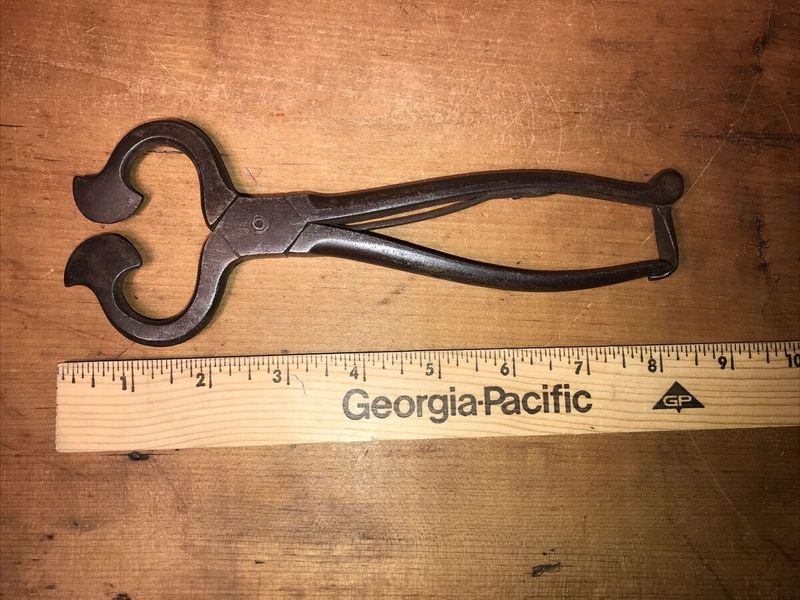
The first time I saw sugar nippers in an antique shop, I mistook them for medieval torture devices. “Those were for sugar cones, not interrogations,” laughed the shopkeeper, explaining their sweet purpose in historical kitchens.
Before granulated sugar became commonplace, sugar was sold in large, rock-hard conical loaves from which pieces needed to be broken off for use. Sugar nippers—resembling heavy iron pliers with sharp, flat blades—were designed to chip manageable pieces from these dense cones. Users would hold the sugar cone in one hand and use the nippers to break off small portions that could then be ground into usable form.
The quality of sugar nippers often reflected a household’s social standing, with wealthy families displaying ornate silver or brass models while working-class kitchens used simple iron tools. Sugar itself was once so valuable that many families kept their sugar cones locked in special boxes, bringing them out only when needed. The ritual of nipping sugar became associated with hospitality, often performed in front of guests to demonstrate generosity.
21. Match Safe: The Fire Keeper
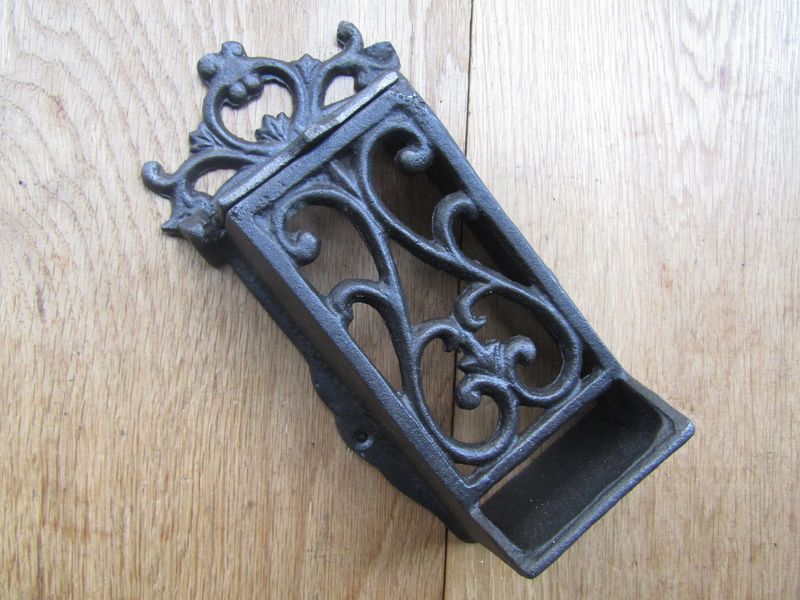
The tiny tin box mounted beside my grandmother’s cookstove puzzled me until she explained its critical role in daily cooking. “Before electric starters, your first kitchen task each morning was lighting the stove with matches from this safe,” she said.
These small containers protected precious matches from moisture, accidental ignition, and curious children. Typically wall-mounted near stoves for convenience, match safes featured a compartment for storing matches and often included a striking surface for lighting them. Many designs incorporated a small tray to hold used matches until they cooled completely—an important fire safety feature in wooden homes.
Match safes reflected both functionality and decoration, with designs ranging from simple tin boxes to elaborate cast iron or brass containers with embossed patterns. Some featured spring-loaded doors that closed automatically after removing matches, while others included small windows to monitor match supply. In an era when fire was essential for cooking, heating, and lighting, these humble containers played a crucial role in household management and safety.
22. Drip Coffee Pot: The Morning Motivator
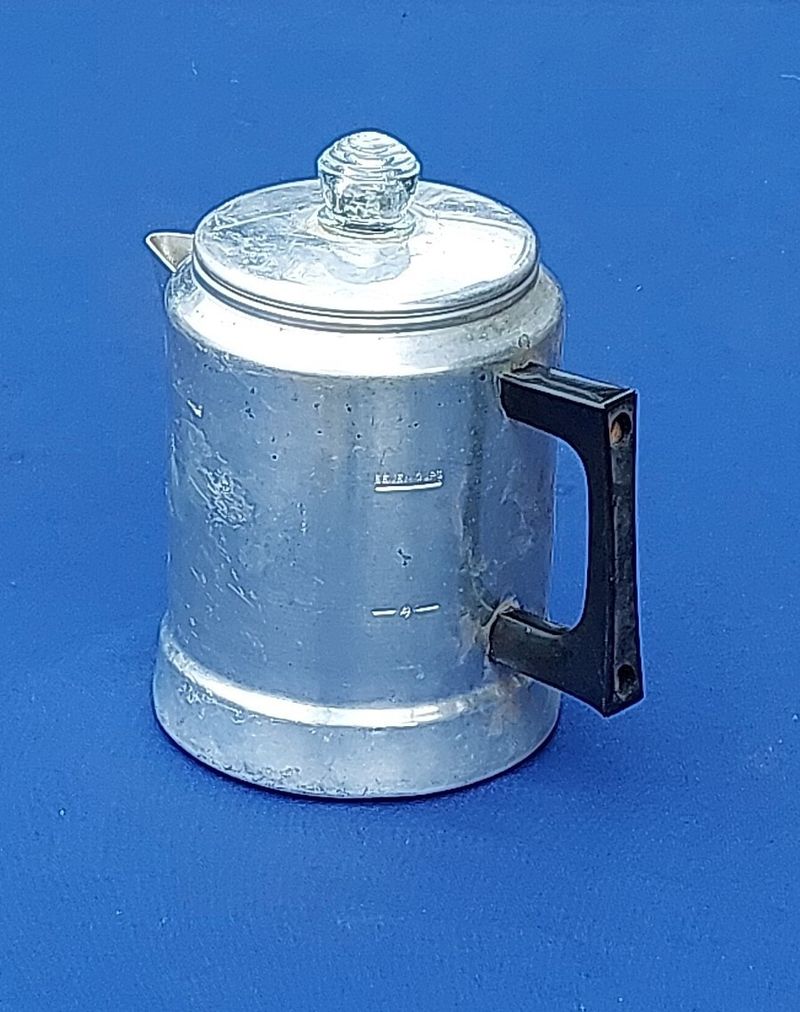
The rhythmic gurgling of my grandfather’s stovetop percolator remains one of my most comforting childhood memories. “Coffee doesn’t taste right unless you hear it perking,” he’d insist while preparing his morning brew.
Before electric coffee makers, these ingenious pots used heat and simple physics to brew coffee. The most common design—the percolator—featured a central tube extending from a small chamber at the bottom to near the top of the pot. As water heated, it would rise through the tube, spill over coffee grounds held in a perforated basket, and then drip back down, continuously cycling through the grounds until desired strength was reached.
These coffee pots were crafted from enameled steel, aluminum, or copper and designed to withstand direct heat from wood stoves or gas flames. Many featured glass knobs on their lids, allowing users to monitor the percolation process. The characteristic burbling sound and rich aroma became morning rituals in households across America, signaling the start of a new day long before programmable coffee makers existed.
